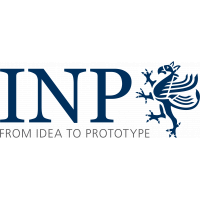This data set contains the data shown in the corresponding publication in Plasma Sources Science and Technology (https://doi.org/10.1088/1361-6595/acb815). This publication presents the first implementation of terahertz (THz) quantum cascade lasers (QCLs) for high-resolution absorption spectroscopy on plasmas. Absolute densities of ground state atomic oxygen were directly obtained by using the fine structure transition at approximately 4.75 THz. Measurements were performed on a low-pressure capacitively coupled radio frequency oxygen discharge. The results show that the presented method is well suited to measure atomic oxygen densities, and it closes the THz gap for quantitative atomic density measurements in harsh environments such as plasmas.
| Field | Value |
|---|---|
| Group | |
| Authors | |
| Release Date | 2023-01-16 |
| Identifier | b2722fbc-7f1b-422a-9ced-b586eefc162b |
| Permanent Identifier (DOI) | |
| Permanent Identifier (URI) | |
| Is supplementing | |
| Plasma Source Name | |
| Plasma Source Application | |
| Plasma Source Specification | |
| Plasma Source Properties | An asymmetric capacitively coupled radio frequency discharge was investigated. The planar RF electrode was made of stainless steel and had a diameter of 120 mm. It was powered at 13.56 MHz by an RF generator (Advanced Energy, Cesar 133) and an automatic matching network (Advanced Energy, Navio). The RF electrode was positioned at a distance of 55 mm beneath the top surface of the grounded reactor vessel, which consisted of aluminum and was cylindrically shaped, with a diameter of 240 mm and a height of 105 mm. The applied RF power was varied between 20 and 100 W. |
| Plasma Source Procedure | Before filling the reactor vessel with oxygen gas, it was pumped to a base pressure of p<5E-4 mbar by a turbopump system (Pfeiffer Balzers, TSU 062). After that, oxygen was admitted to the vessel and the pressure was adjusted to 0.7 or 1.3 mbar, respectively. |
| Plasma Medium Name | |
| Plasma Medium Properties | Pure O2 was used as a working gas, at a pressure of 0.7 or 1.3 mbar, and a flow rate of 70 sccm. The gas flow was set to 70 sccm by a mass flow controller (MFC) (MKS 1179A with control unit MKS 647C) connected to an oxygen gas cylinder (Air Liquide, gas purity 99.998%). |
| Plasma Diagnostics Name | |
| Plasma Diagnostics Procedure | Absolute densities of ground-state atomic oxygen were measured with THz absorption spectroscopy, using the fine structure transition of atomic oxygen at 4.74477749 THz (i.e. 158.268741 cm-1). A tunable THz QCL in continuous-wave mode was used as the radiation source. The THz QCL was operated in a Stirling cryocooler (Ricor K535) at a temperature of either 44.30 or 54.45 K. The laser temperature was regulated by an additional temperature controller (Stanford Research Systems, CTC100), which was capable of a temperature control with <5 mK stability. Tuning of the laser frequency was achieved by linearly ramping the input current. The current was supplied by a laser driver (Wavelength Electronics, QCL1000 OEM) that was controlled by a function generator (Tektronix, AFG3022C) to provide sawtooth waveforms with a frequency of 10 Hz. A phase-locked optical chopper (New Focus, Model 3502) with a frequency of 5 Hz was used to block each second period of the laser output. The generated THz radiation was collected by a gold-coated parabolic mirror to produce a collimated beam with a diameter of approximately 3 mm. A window made of silicon allowed for the laser beam to pass through the plasma reactor, at a height of approximately 18 mm above the RF electrode. A gold-coated mirror at the back end of the reactor reflected the laser beam back towards the entrance window. The effective absorption length was estimated to be 84 cm (i.e. the total length of the laser beam path within the plasma reactor). After passing through the plasma reactor, the laser radiation was detected by a helium-cooled bolometer (Infrared Laboratories, 4.2K Bolometer). The detected signals were recorded with a digital sampling oscilloscope (R&S, RTO 1014). |
| Language | English |
| License | |
| Public Access Level | Public |
| Contact Name | Jente Wubs |
| Contact Email |
Data and Resources
- Terahertz absorption spectroscopy for measuring atomic oxygen densities in plasmas - Fig. 2csv
Simulated transmission spectra (T = 296 K) of ammonia and atomic oxygen from...
Preview Download - Terahertz absorption spectroscopy for measuring atomic oxygen densities in plasmas - Fig. 3csv
Raw spectrum from a simultaneous measurement of a reference gas cell with...
Preview Download - Terahertz absorption spectroscopy for measuring atomic oxygen densities in plasmas - Fig. 4csv
Comparison of the absorption spectra of a reference gas cell with NH3 (p=0....
Preview Download - Terahertz absorption spectroscopy for measuring atomic oxygen densities in plasmas - Fig. 5csv
Spectral absorption profile of the sR(7,3)-transition of 14NH3 at 158.214792...
Preview Download - Terahertz absorption spectroscopy for measuring atomic oxygen densities in plasmas - Fig. 6csv
Spectral absorption profile of the R(7,5)-transition of 15NH3 at 158.257314...
Preview Download - Terahertz absorption spectroscopy for measuring atomic oxygen densities in plasmas - Fig. 7csv
Spectral absorption profile of the fine structure transition of atomic...
Preview Download - Terahertz absorption spectroscopy for measuring atomic oxygen densities in plasmas - Fig. 8csv
Comparison of atomic oxygen densities as a function of the applied RF power...
Preview Download

![[Open Data]](https://assets.okfn.org/images/ok_buttons/od_80x15_blue.png)